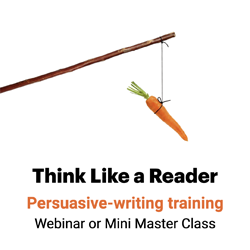Use you for all audiences, channels
You. It’s a power tool of communications.

The second person increases readability, boosts opens and clickthroughs and is the most retweeted word in the English language.
So lead with you whether you’re writing for clients, employees, reporters or visitors. Indeed, use the Y word when you’re writing:
1. Marketing communications
The second person was, is and always will be the recognized standard for brochures, sales collateral and other marketing pieces. That’s why the best marketing communications are verb-based benefits lists that sound like this:
Grow bigger, lusher plants — and never have to water again — with XYZ’s SuperPlantGro.
2. Employee communications
C’mon. You’re not still referring to employees as employees in employee communications. Right? Overcome the distance between employees and the organization by writing directly to employees, using you or the imperative voice.
So instead of:
Employees must pick up new car stickers by Sept. 25
Write:
Don’t get stuck at security: Get your new car stickers by Sept. 25
3. Public relations
Communicators have long believed that there’s no place for you in media relations. Why? Two reasons:
- News releases, conventional wisdom goes, require the third person for an objective, journalistic tone. But have you looked at a news outlet lately? Even the stodgiest now often use the second person.
- Who’s you? Is it the reporter who receives the release or the reporter’s reader who actually reads the story? However, given organizations’ goals for releases today, this seems like a non-problem too.
I’ve seen enough PRSA Silver Anvil Award-winning releases use you that I’ve almost come around to the idea. But I still think there’s a better choice.
If you don’t want to use the second person in media relations pieces, you can still focus on reader benefits by using a placeholder for you in the first position in the release. That’s what makes this lead from a Silver Anvil Award-winning campaign lead so effective:
4. Multiple audiences
Remember back in the day, when Step 2 of the five-step communication planning process was “target your audience”? A whole step — 20% of the process — devoted just to answering the question, “Who’s you?”
But then — and, yes, I am aware of just how old this makes me sound — [read in creaky, old-lady voice] the internet came along, Sonny, and suddenly, our audience was everyone.
So how do you write to you when you’re not sure who you is? You have three options:
- Segment audiences. This remains the best practice. If you’re reaching out to investors, employees and consumers, you have three pieces. The bulk of the piece might be the same, but the top two or three paragraphs will change with the audience.
- Call out to readers. Not possible to segment? Then take David Ogilvy’s advice, and call out to your segment in the headline. Just add, “Mothers of Kindergartners:” or “Asthma sufferers:” or “Kansas City residents:” to the front of your headline.
- Let readers segment themselves. The National Institutes of Health used to have two doors on its home page: Doctors and Patients. That way, NIH could be sure that I never saw my doctor’s content, and that my doctor never saw mine.
Because the minute my doctor gets a high blood pressure article intended for me, she decides the NIH site is not for her. And the minute I get the hypertension piece slanted toward my doctor, I decide the NIH site is not for me.
That’s the problem with failing to segment audiences: Give people information that’s targeted to someone else, and you may lose them altogether.
This also works with social media. I live in Portland, a city divided by the Willamette (rhymes with damn it) river. A dozen bridges connect the east and west sides.
If my bridge is down, I want to receive updates from ODOT every five seconds. If your bridge is down? I never want to get bothered by it at all.
The solution? Let people sign up for the bridge feeds they want to follow.
Then you know who your reader is. Then you have no trouble talking to you.

Leave a Reply